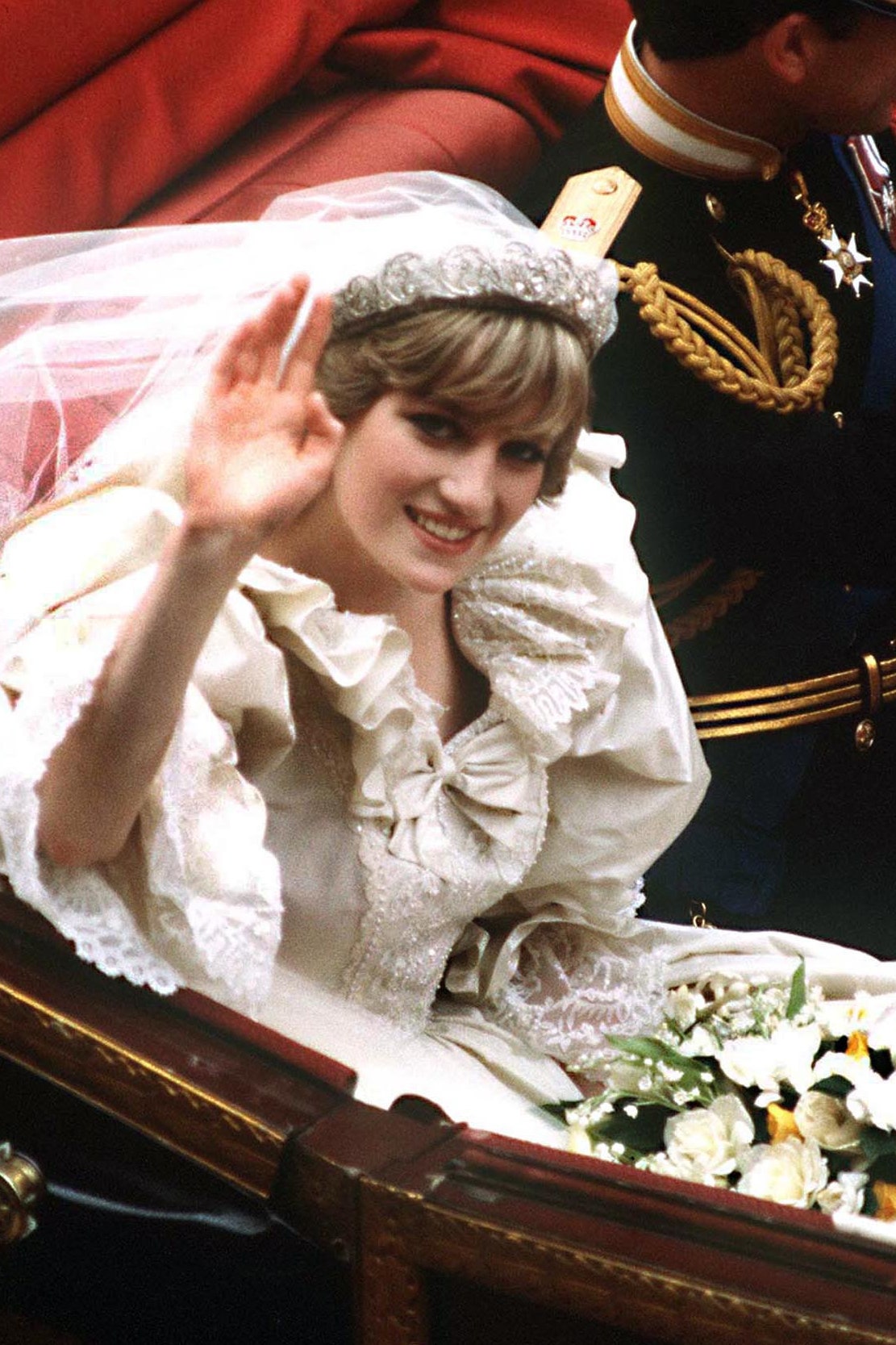Every royal wedding prompts frenzied speculation over which tiara the bride will wear. On her wedding day in 1981, the 19-year-old Lady Diana Spencer observed age-old tiara etiquette by not borrowing from the royal vault. Instead, she emerged from her carriage at St Paul’s Cathedral with her own family’s heirloom, the Spencer tiara, securing her 140-metre David and Elizabeth Emanuel-designed tulle veil.
Since the 19th century, tiaras have served as sparkling signifiers of transition. Traditionally a bride wore her “family fender” to mark her change of status from a daughter to a wife, thereafter wearing the headpieces of her husband’s family. Diana broke protocol though. The Spencer tiara remained a firm favourite for formal events throughout her marriage. Since then, it’s made only rare appearances at private family weddings – until this month, when it stars in Sotheby’s Aristocratic Jewels exhibition of 46 tiaras, celebrating the Queen’s Platinum Jubilee with the largest collection of headpieces exhibited for decades.
Although the Spencer family history stretches back to the 15th century, the tiara was assembled in 1930 by Garrard from several old Spencer diamond jewels, which surround a central diamond floral piece, gifted to Lady Cynthia Hamilton on the occasion of her wedding to Diana’s grandfather, the 7th Earl Spencer. Legendary Vogue hairdresser Sam McKnight confirmed that tiaras often gave Diana headaches – most likely she favoured the Spencer tiara for its lightness and comfort.
Every type of headpiece is represented in the exhibition; from showstopping Russian kokoshniks to Gothic and Empire styles, Cartier art deco masterpieces, Scandinavian wedding bandeaus and classic English diadems (and many of them look like headache material).
A glittering burden accumulates from the frame, diamonds and sharp mechanisms allowing the headpiece to be broken down into brooches and necklaces. The dazzlingly grand 19th-century heirlooms from stately homes across the country; the Derby, Fitzwilliam, Roseberry, and Devonshire Palm and Lotus, on loan from Chatsworth, are not for the faint-hearted. At the 1902 Coronation of King Edward VII, the Duchess of Devonshire stumbled under the weight of the magnificent Palm and Lotus, and it went tumbling into the street.
There are other tiaras with royal connections, such as the diamond and aquamarine tiara gifted to Lady Edwina Mountbatten by Tsar Nicholas II of Russia. Also, Queen Victoria’s favourite emerald and diamond diadem will arrive from Kensington Palace on the eve of the exhibition. The tiara was designed by Prince Albert and completed in 1845 by Joseph Kitching at a cost of £1,150, and has remained almost untouched since its creation. Although history doesn’t record a comfort rating given by Queen Victoria, her descendants have had stressful moments proving that it can take a certain strength of character to carry off a tiara. A few years ago, one of the emeralds fell out on the way to the State Opening of Parliament, so the Duchess of Fife tied it back in place with fuse wire and off she went.
The Westminster Halo tiara made its 1930 debut in Vogue. Loelia, third wife of Hugh Grosvenor, the Duke of Westminster (famous for being the onetime lover of Coco Chanel), wore the newly completed Lacloche jewel in a Cecil Beaton portrait. Its next appearance would follow 22 years later, on the head of the Duke’s fourth wife, Anne, at the coronation of Queen Elizabeth II.
The sparkliest gathering of tiaras in recent history was at Her Majesty’s coronation on 2 June 1953, and at least a dozen of the tiaras on display at Sotheby’s adorned aristocratic heads assembled in Westminster Abbey that day. These tiaras offer a glimpse into history. As the coronation approached, mothballed robes and coronets were dusted off, and jewels were removed from banks or vaults and taken to Garrard for cleaning, as everyone wanted their tiara to dazzle the brightest. Many tiara-topped peeresses dressed in ermine cloaks swept into the Vogue studios to be photographed by Beaton for the coronation issue.
Some of the head ornaments date from the fashionable rise of the tiara, sparked by Napoleon and Josephine in the early 19th century, to their mid-20th century peak, after which appetite for them began gently dying out. Later 20th-century examples are included in the exhibition, such as a vibrant 1960s turquoise and diamond piece by Van Cleef & Arpels, and a striking Charles de Temple gold and emerald modernist jewel. Two new tiaras have also been specially created to celebrate contemporary British craftsmanship: one by goldsmith Christopher Thompson Royds and one by jewellery designer Kiki McDonough.
A few of the tiaras will be offered for sale. Despite being something of a fashion dinosaur, tiaras are highly prized today. “There’s an incredible demand for tiaras and we’ve seen phenomenal prices in the last few years”, says Kristian Spofforth, head of London jewellery at Sotheby’s and curator of the exhibition, “Even certain unspectacular pieces which are just bog-standard tiaras have doubled in price.” Many wealthy buyers are on the market looking for portable wealth, and even in these egalitarian times, a bridal tiara for their daughter. There’s a bewitching magic as well as enduring value in an antique tiara. “Even if you sell it years later, it’ll remain an important tiara, especially if it comes with a provenance.” A piece worn by royal command at Her Majesty’s coronation is the dream.
“There are pieces that you hold, and you do get a slight chill,” continues Spofforth, turning the Spencer tiara over in his hands. “It’s amazing because of its provenance and Diana – there’s a tangible sense of its history, power and influence.” Tiaras remain a regal fairytale fantasy, and this exhibition is a rare chance to see some of the finest examples around.
The Aristocratic Jewels exhibition will run at Sotheby’s New Bond St from 28 May to 28 June
